Do you remember Shelley (a.k.a. Lightning McStitch) with that amazing Evel Knievel costume? Well, she’s back, this time with a really sweet tutorial for you.
This time she’s here to demonstrate how she made these adorable ruffled bloomers using the Tea Party Bloomer pattern. Thanks so much, Shelley!
This December there were so many beautiful Christmas dresses and outfits appearing in the Oliver + S Flickr group that I couldn’t help but get into the sewing spirit. Our Christmas can be unbearably hot and the Australian toddler may end up wearing nothing more than a singlet and a nappy on Christmas day. So, here comes another pair of ruffled Tea Party Bloomers to fancy-up that yuletide backside.
I’ve done this twice now, and I’m sure there could be better, neater or easier ways, so I’d like to consider this an “open” tutorial, where I’ll show what I did, and your comments may improve the whole process. A Flickr search demonstrated that there are some very experienced ruffle-ists among the Oliver + S devotees.
Starting with the Oliver + S Tea Party Bloomers pattern, I’ve cut out the two pattern pieces and leg bias binding, and then cut two strips of fabric about 1 3/4″ x 25″ for the ruffles. Initially I cut the ruffle strips longer, but the rolled hem becomes quite stiff and it gets hard to gather them enough. A little shorter would be fine if you had a limited amount of fabric.
Press one long edge of each ruffle strip to the wrong side by 1/2″ to create the rolled hem. I’m a metric person but through sewing “NYC style” I’m starting to get an eye for the imperial measurements. However, I still love using my cardboard backed, glued on, downloaded hem guide from the Scientific Seamstress.
To create the rolled hem, it pays to be on good terms with your sewing machine. My machine and I were not getting on well when I made this pair (I suspect an old blunt needle could have been part of the problem), and it took quite a few practice runs on test fabric to get needle tension and stitch length right (or as close as I could be bothered with!). I don’t have a serger or a rolled hem foot, so I’ve just used my edgestitch foot and made do. I used a variegated thread on top and bottom, as the rolled hem is going to stick out enough to be seen on both sides. Liesl gives some nice instructions on creating a rolled hem in the Family Reunion pattern for the ruffle tab option.
I set my machine to a medium width, zigzag stitch of very short stitch length and aimed to get the needle to land right on, or slightly over, the folded edge of the fabric.
Start and stop the satin stitch about 1/2″ from each end of the ruffle. With scissors, trim the remaining seam allowance away from the stitched edge as neatly as possible.
Press the other long edge of the ruffle strip to the wrong side by about 3/8″. Then sew two lines of gathering stitches along the length of the ruffle strip. The first row of stitching should be on or slightly below the opened-out crease and the next about 3/8″ below. Leave long thread tails at each end.
Now, to the bloomers. Construct the bloomers as per the pattern instructions right up to the point of inserting any elastic.
With the bloomers right side out, use fabric chalk to mark the lines along which you want to attach the ruffles. I’ve done the first ruffle about 1″ below the stitched waistband line, and the second line about 1 1/2″ below the first. I didn’t mark the lines, but probably should have as they’re a bit wonky! To attach the ruffle I folded over the short end by about 1/2″ and pinned it to the side seam of the bloomers.
Refolding the seam allowance crease as you go, pin the gathered ruffle to the bloomers until you reach the other short end. Pin that short end with the seam allowance folded under to the other side seam. Here’s where I wonder if it wouldn’t be easier to have sewn the gathering stitches through the folded under seam allowance as well. Can two layers of fabric be gathered as easily as one?
Stitch the ruffle to the bloomer back panel about 1/4″ from the folded edge. Start by stitching along the short folded edge at the side seam, then pivot to continue along the length of the gathered ruffle, pivoting again to finish by going down the other short folded edge. Remove the gathering stitches as necessary. I left the top ones in as I’d stitched almost on top of them.
Attach the second (or third or fourth!) ruffle in the same manner.
Finish the bloomers by inserting the leg and waist elastic and closing the casings.
Voila! Some leftover calico has been turned into “fancy pants.” The hard part is convincing my toddler she really should put a skirt over the top before we go out anywhere!
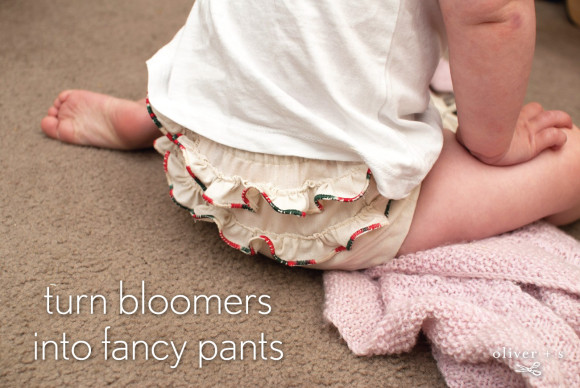


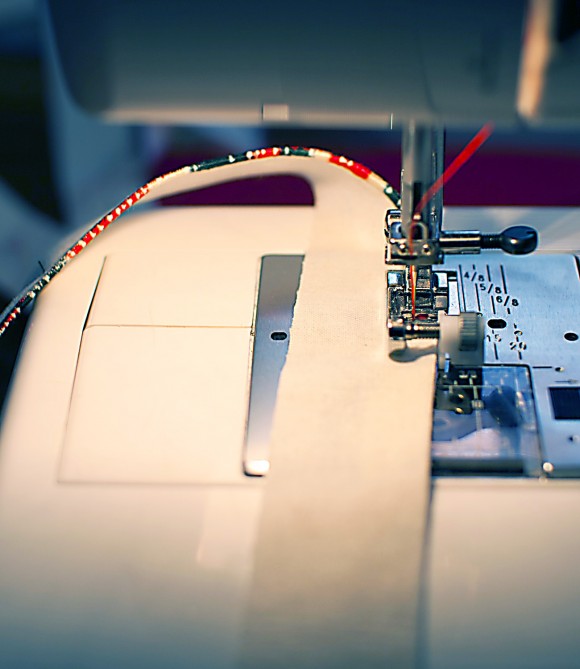
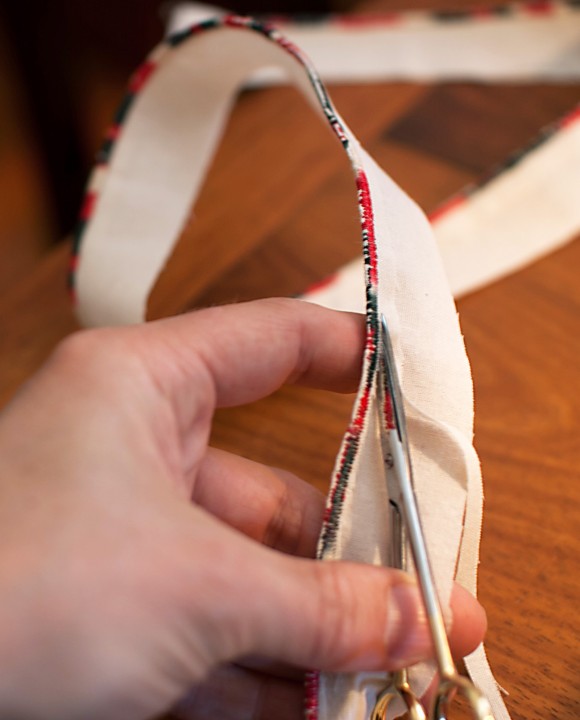
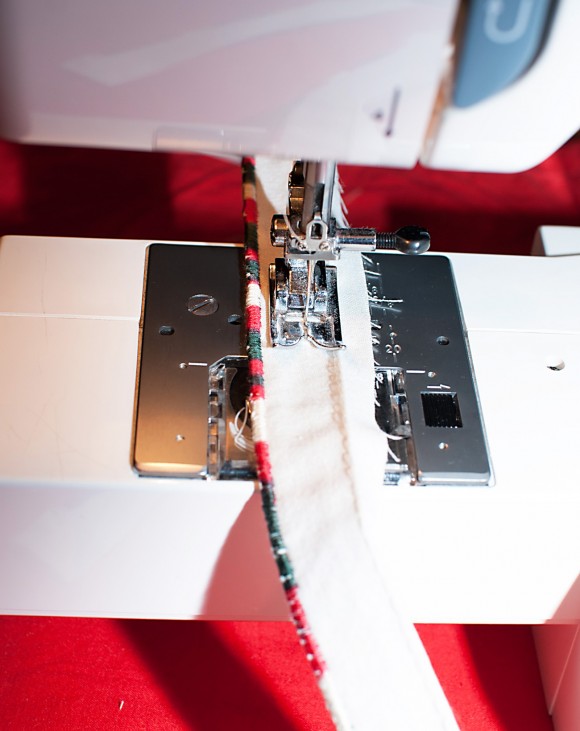
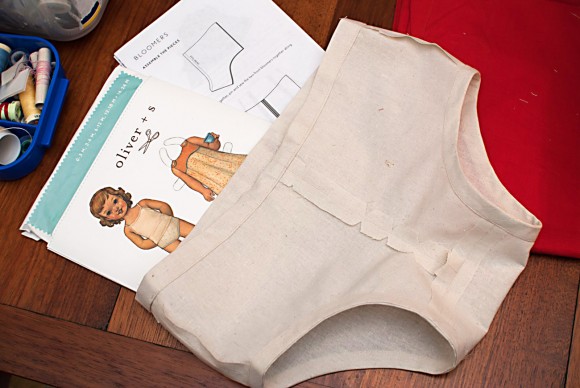

Cute! Thanks for sharing how you constructed the ruffles.:)
Back in my Carter’s baby clothes designing days we called this a “rumba-butt”! Very sweet!
These are so cute – I wonder whether it would work using bias binding to edge the ruffles rather than edge stitching? My machine is a little limited and I’m thinking that some liberty print bias binding could be incredibly sweet.
Oh Carie, wouldn’t it be beautiful to make each ruffle out of a different liberty print. I’d just make a wee narrow hem for the free edge as the liberty would be fine enough for that not to be too bulky, and then fold over and attach as I did for the calico ruffle. Three or four ruffles of different liberty prints would be awesome.
some questions or thoughts –
i think you can gather two layers of fabric, i know on the tutu in the book it had like 8 layers. Granted this was tulle, but it was gathered very tightly and worked just fine.
I wonder if another way to construct the ruffle would be to sew a tube out of the ruffle strip (meaning, right sides facing sew around the two long edges plus one other and then turn it and press. Then do the edge stitching with the thread, and then gather as you did. You wouldnt have exposed edges so wouldnt need to mess with the folding under. However I’m no ruffle expert so not sure if this would make wonky ruffles or not. Especially for a thin fabric like the liberty I imagine it might work.
Absolutely, Sara! Especially if you’re using a lightweight fabric. (Hello, Liberty!) I think you could take all sorts of directions here, including finishing both edges of a strip in the same way Shelley finished one edge. Then you could ruffle down the center of the strip, which would also be cute. You could also stitch the ruffles to the back bloomers before you assemble them, which would catch the ends of the ruffle in the side seams and probably be really easy to sew. I hope you’ll all be playing with this–it would be fun to see more of them show up in the Flickr group!
I put it up in the Flickr group now. (I still need to get some smaller elastic for the legs).
I made a tube out of the liberty fabric and edge stiched one side. I sewed it on before constructing the sides so it is sewn into the side seams.
Worked pretty well, thanks for the tutorial and tips!